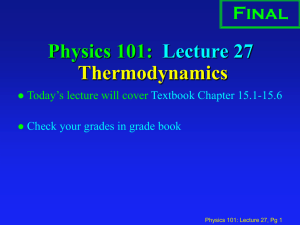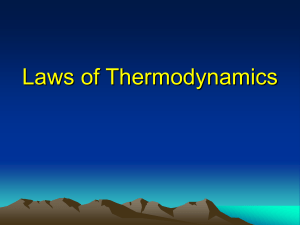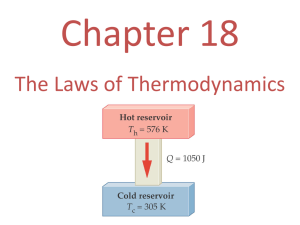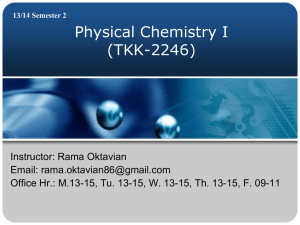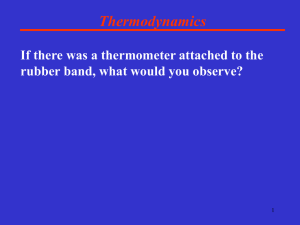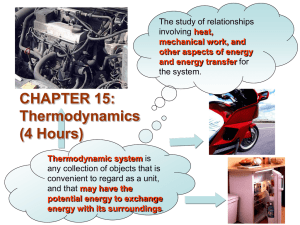Temperature, Heat Transfer, and First Law of
advertisement
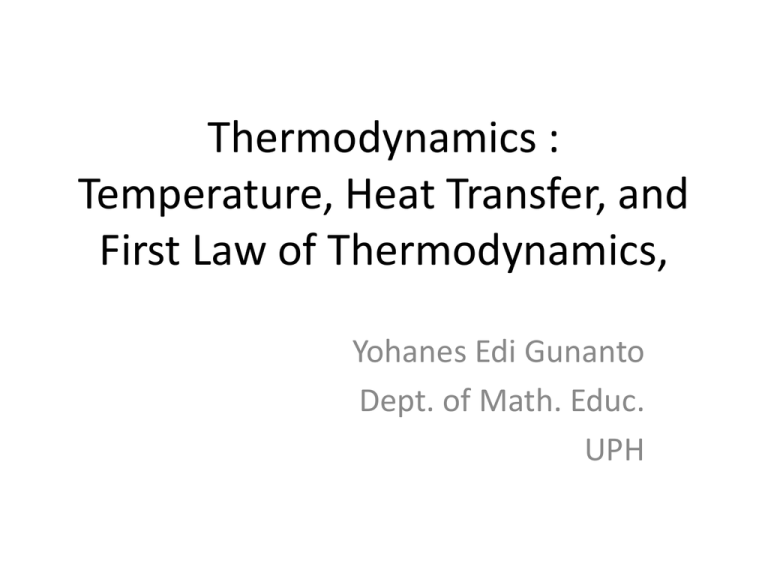
Thermodynamics : Temperature, Heat Transfer, and First Law of Thermodynamics, Yohanes Edi Gunanto Dept. of Math. Educ. UPH Temperature Apakah Suhu = Panas ? • Apa yang dimaksud dengan Suhu ? • Apa yang dimaksud dengan Panas ? Apa yang terjadi ketika benda padat, cair dan gas menerima panas ? Ketika menerima panas, molekulmolekul bergerak makin lama makin cepat ! • Inilah yang disebut dengan pemuaian • Jadi apakah pemuaian itu ? Mengapa termoemeter dapat digunakan untuk mengetahui panas suatu benda ? Bandingkan skala-skala termometer di bawah ini Bagaimana cara panas berpindah? Panas berpindah dari benda bersuhu panas ke benda bersuhu dingin Panas berpindah dengan cara konveksi, konduksi dan radiasi Konduksi Perpindahan panas tanpa memindahkan penghantarnya Konveksi • Perpindahan panas dengan memindahkan perantaranya Radiasi • Perpindahan panas tanpa memerlukan perantara THERMODYNAMICS BASICS Zeroth Law A B C If A and B and B and C are in thermal equil, then A and C are in thermal equil. [ie. At same T] First Law of Thermodynamics Conservation of Energy for Thermal Systems Joule Equivalent of Heat • James Joule showed that mechanical energy could be converted to heat and arrived at the conclusion that heat was another form of energy. • He showed that 1 calorie of heat was equivalent to 4.184 J of work. 1 cal = 4.184 J Energy • Mechanical Energy: KE, PE, E • Work is done by energy transfer. • Heat is another form of energy. Need to expand the conservation of energy principle to accommodate thermal systems. 1st Law of Thermodynamics • Consider an example system of a piston and cylinder with an enclosed dilute gas characterized by P,V,T & n. 1st Law of Thermodynamics • What happens to the gas if the piston is moved inwards ? 1st Law of Thermodynamics • If the container is insulated the temperature will rise, the atoms move faster and the pressure rises. • Is there more internal energy in the gas? 1st Law of Thermodynamics • External agent did work in pushing the piston inward. • W = Fd • =(PA)Dx • W =PDV Dx 1st Law of Thermodynamics • Work done on the gas equals the change in the gases internal energy, W = DU Dx 1st Law of TD • Let’s change the situation: • Keep the piston fixed at its original location. • Place the cylinder on a hot plate. • What happens to gas? Heat flows into the gas. Atoms move faster, internal energy increases. Q = heat in Joules DU = change in internal energy in Joules. Q = DU 1st Law of TD • What if we added heat and pushed the piston in at the same time? F 1st Law of TD • Work is done on the gas, heat is added to the gas and the internal energy of the gas increases! Q = W + DU F 1st Law of TD Some conventions: For the gases perspective: • heat added is positive, heat removed is negative. • Work done on the gas is positive, work done by the gas is negative. • Temperature increase means internal energy change is positive. First Law of Thermodynamics “Energy cannot be created or destroyed. It can only be changed from one form into another.” Rudolf Clausius 1850 First Law of Thermodynamics • Conservation of Energy • Says Nothing About Direction of Energy Transfer 1st Law of TD • Example: 25 L of gas is enclosed in a cylinder/piston apparatus at 2 atm of pressure and 300 K. If 100 kg of mass is placed on the piston causing the gas to compress to 20 L at constant pressure. This is done by allowing heat to flow out of the gas. What is the work done on the gas? What is the change in internal energy of the gas? How much heat flowed out of the gas? • Po = 202,600 Pa, Vo = 0.025 m3, To = 300 K, Pf = 202,600 Pa, Vf=0.020 m3, Tf= n = PV/RT. W = -PDV DU = 3/2 nRDT Q = W + DU W =-PDV = -202,600 Pa (0.020 – 0.025)m3 =1013 J energy added to the gas. DU =3/2 nRDT=1.5(2.03)(8.31)(-60)=-1518 J Q = W + DU = 1013 – 1518 = -505 J heat out Quasistatic Processes in an Ideal Gas isochoric ( V = const ) P W 1 2 0 2 PV= NkBT2 PV= NkBT1 1 V1,2 V Q 1 2 3 2 Nk B T 2 T1 0 (see the last slide) dU Q1 2 isobaric P C V D T ( P = const ) 2 W 1 2 P (V , T ) dV P V 2 V1 0 2 1 V1 1 PV= NkBT2 PV= NkBT1 V2 V Q 1 2 5 2 Nk B T 2 T1 0 dU W1 2 Q1 2 C P D T Isothermal Process in an Ideal Gas P isothermal ( T = const ) : PV= NkBT W V2 dU 0 V2 V1 V W 1 2 P (V , T ) dV Nk B T V1 W i f Nk B T ln Vi Vf Wi-f > 0 if Vi >Vf (compression) Wi-f < 0 if Vi <Vf (expansion) V2 V1 Q1 2 W 1 2 dV V Nk B T ln V2 V1 Adiabatic Process in an Ideal Gas Q1 2 0 adiabatic (thermally isolated system) dU W1 2 The amount of work needed to change the state of a thermally isolated system depends only on the initial and final states and not on the intermediate states. V2 W 1 2 P (V , T ) dV P V1 2 PV= NkBT2 PV= NkBT1 1 V2 PV Nk B T V1 to calculate W1-2 , we need to know P (V,T) for an adiabatic process f U 2 Nk B T PdV VdP Nk B dT V ln V1 f dU 2 Nk B dT PdV ( f – the # of “unfrozen” degrees of freedom ) V dV 2 dP 0 1 V f P , 1 PdV VdP 2 f V 2 Adiabatic f exponent dV V1 P ln 1 P PV PdV PV P1V1 const V P P1 dP P 0 Adiabatic Process in an Ideal Gas (cont.) PV P P1V1 const 2 V2 1 PV= NkBT2 PV= NkBT1 V1 V V2 An adiabata is “steeper” than an isotherma: in an adiabatic process, the work flowing out of the gas comes at the expense of its thermal energy its temperature will decrease. V2 W 1 2 P (V , T ) dV V1 P1V1 V1 P1V1 V dV P1V 1 1 1 V2 V 1 V1 1 1 1 1 1 V2 V1 1 1+2/31.67 (monatomic), 1+2/5 =1.4 (diatomic), 1+2/6 1.33 (polyatomic) (again, neglecting the vibrational degrees of freedom) Prove W 1 2 f 2 D PV f 2 NkB DT DU Summary of quasi-static processes of ideal gas DU U Quasi-Static process isobaric (DP=0) isochoric (DV=0) isothermal (DT=0) adiabatic (Q=0) f Ui DU f DU 2 DU f 2 Q f NkB DT NkB DT f 2 P DV 2 f 2 D P V DU 2 NkB DT 2 D PV Vi PDV Ti f Pi D P V W f W 2 2 0 f PDV Ideal gas law 0 0 N k B T ln DU Tf Ti Vf Vf Pf Tf PV Pf V f i i Vi PV Pf V f i i TUHAN MEMBERKATI
